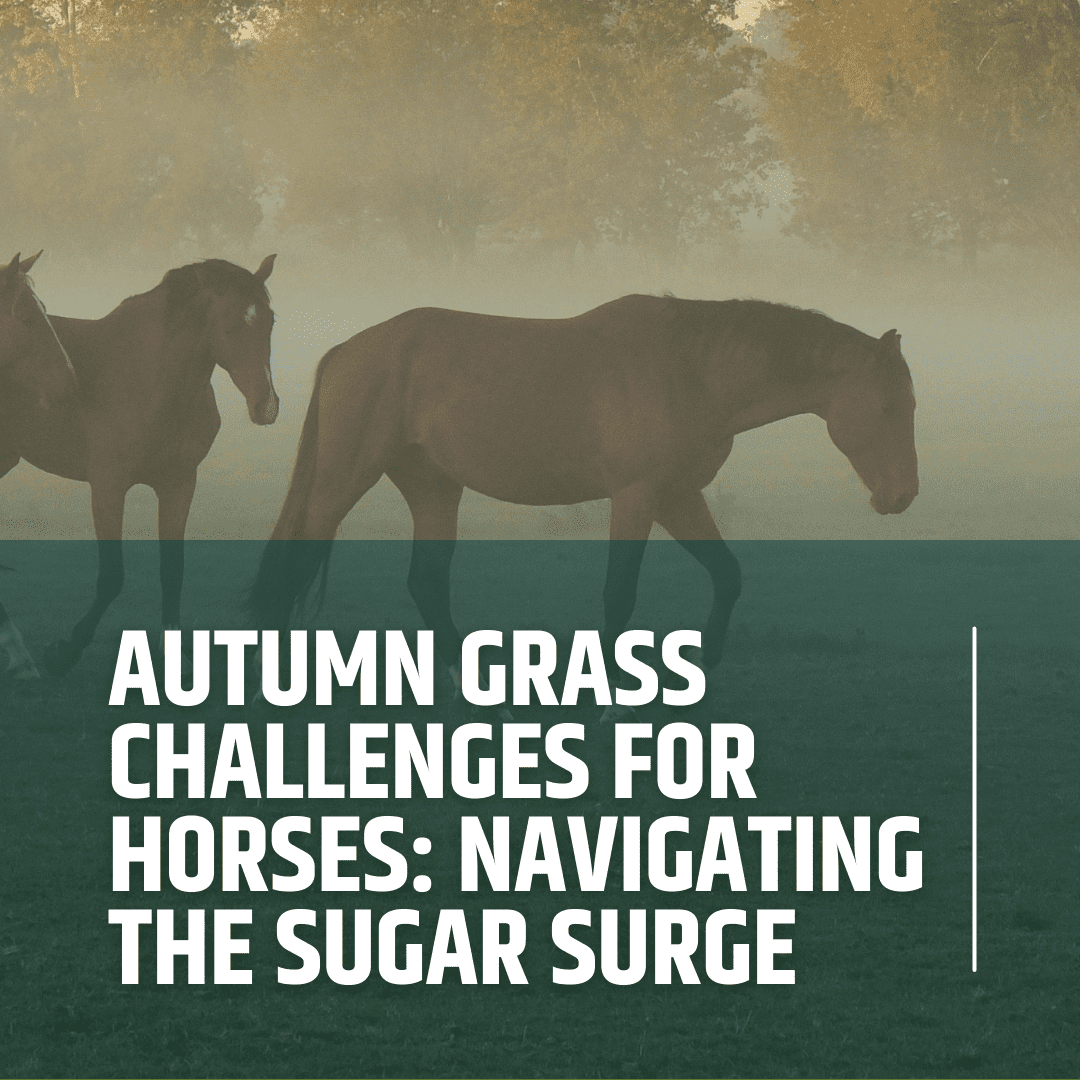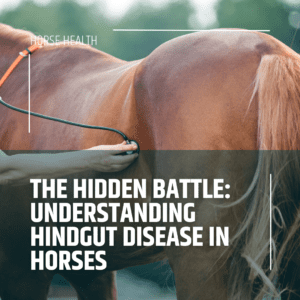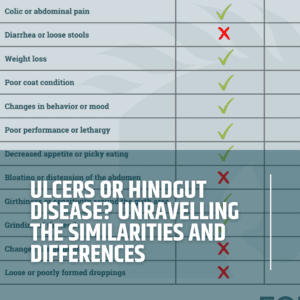
01
Introduction
As the crisp autumn air settles over Europe, horse owners face a unique set of challenges when it comes to managing their horses’ grazing habits (1). While many associate spring with the highest grass sugar levels, autumn can be equally, if not more, problematic. This article explores the grass-related issues that arise in September and beyond, offering insights and strategies to keep your horses healthy during this transitional season.
02
Why Sugar Levels Rise
As days grow shorter and the temperature fluctuates between warm days and cool nights, grass plants undergo physiological changes to prepare for winter (2). This process often involves converting starches to sugars, which act as a natural antifreeze (2 & 3). Consequently, grass sugar levels can spike dramatically during autumn, sometimes surpassing spring levels.
03
The Risk to Horses
High sugar content in grass poses several risks to horses (4), particularly those prone to conditions such as:
- Laminitis
- Equine Metabolic Syndrome (EMS)
- Insulin Resistance
- Obesity
Even horses without these predispositions can experience digestive upset, behavioural changes, and energy imbalances when consuming high-sugar grass.
04
Warm Days, Cool Nights
The autumn pattern of warm days followed by cool nights creates ideal conditions for sugar accumulation in grass:
- During warm, sunny days, grass photosynthesizes actively, producing sugars (5)
- Cool nights slow down the grass's metabolism, reducing its ability to use these sugars for growth (6)
- As a result, sugars accumulate in the grass, leading to higher concentrations, especially in the morning (6)
05
Stress-Induced Sugar Production
Autumn weather can be unpredictable, with fluctuating temperatures and occasional dry spells. These stressors can trigger increased sugar production in grass as a survival mechanism, further complicating grazing management (3).
06
Reduced Grass Growth
As grass growth slows in autumn, horses may overgraze certain areas, leading to soil compaction and potential damage to grass roots. This can create long-term pasture management issues (7).
07
Managing Autumn Grazing
Limit Grazing Time
Consider restricting grazing access, especially during high-risk periods (7) such as early morning or late afternoon when sugar levels tend to peak due to the warm day-cool night cycle.
Use Grazing Muzzles
Grazing muzzles can be an effective tool to reduce grass intake while still allowing horses to enjoy turnout and natural foraging behaviours (7).
Provide Alternative Forage
Offer low-sugar hay options to supplement reduced grazing time (7). Soaking hay can help lower its sugar content further.
Monitor Body Condition
Regular body condition scoring is crucial during autumn to prevent weight gain, which can exacerbate sugar sensitivity issues.
Consider Supplements
Products like EquiNectar can support horses' digestion of fructans (a type of sugar found in grass) in the small intestine, potentially reducing the risk of hindgut fermentation and associated health issues.
07
Impact on the Hindgut
Understanding the impact of autumn grass on a horse's hindgut is crucial for maintaining equine health during this challenging season.
Hindgut Disruption
High sugar content in autumn grass can lead to significant disruptions in the horse's hindgut (8):
- Microbial Imbalance: The sudden influx of sugars can cause rapid fermentation, leading to an overgrowth of certain bacteria and a decline in beneficial microbes.
- pH Changes: Rapid fermentation of sugars can result in increased acidity in the hindgut, potentially leading to hindgut acidosis.
- Endotoxin Release: Disruptions to the microbial balance can lead to the death of certain bacteria, releasing endotoxins that can trigger inflammatory responses throughout the body.
- Reduced Nutrient Absorption: Changes in the hindgut environment can impair the horse's ability to absorb essential nutrients from their feed.
Consequences of Hindgut Disruption
These disruptions can manifest in various ways (9):
- Increased risk of colic
- Development or exacerbation of laminitis
- Behavioural changes due to discomfort
- Compromised immune function
- Reduced overall performance and well-being
Monitor Body Condition
Regular body condition scoring is crucial during autumn to prevent weight gain, which can exacerbate sugar sensitivity issues.
Consider Supplements
Products like EquiNectar can support horses' digestion of fructans (a type of sugar found in grass) in the small intestine, potentially reducing the risk of hindgut fermentation and associated health issues.
08
How EquiNectar Helps
EquiNectar plays a vital role in mitigating these risks by supporting healthy hindgut function:
- Fructan Digestion: EquiNectar contains enzymes that help break down fructans (a type of sugar found in grass) in the small intestine. This reduces the amount of undigested sugars reaching the hindgut, where they can cause disruptions.
- Maintaining Microbial Balance: By reducing the sugar load in the hindgut, EquiNectar helps maintain a stable microbial population, crucial for proper digestion and overall gut health.
- pH Regulation: With fewer sugars fermenting in the hindgut, there's less risk of rapid pH changes
- Supporting Nutrient Absorption: A healthier hindgut environment promotes better nutrient absorption, ensuring your horse gets the most out of their feed.
By incorporating EquiNectar into your autumn horse management strategy, you're taking a proactive step in protecting your horse's hindgut health. This can lead to improved digestion, reduced risk of sugar-related health issues, and better overall well-being for your horse during the challenging autumn season.
09
The Importance of Vigilance
Autumn's grass challenges require horse owners to be particularly attentive. Regular monitoring of both your horses and your pastures is key to navigating this tricky season successfully. Keep an eye out for signs of discomfort, changes in behaviour, or symptoms of conditions like laminitis.
By understanding the unique challenges posed by autumn grass and implementing proactive management strategies, you can help ensure your horses remain healthy and comfortable as the seasons change. Remember, each horse is an individual, and consulting with your veterinarian or equine nutritionist can help you develop a tailored plan for your specific situation.
As we move through autumn and into winter, stay informed about grass conditions and be prepared to adjust your management practices accordingly. With careful attention and the right strategies, you and your horses can enjoy the beauty of the autumn season while minimising health risks associated with changing grass conditions.
References
[1] Jon Williams Stables. (2023, September 27). Equine Health in Autumn. https://www.jonwilliamstables.co.uk/blog/equine-health-in-autumn/
[2] Nievola, C. C., Carvalho, C. P., Carvalho, V., & Rodrigues, E. (2017). Rapid responses of plants to temperature changes. Temperature (Austin, Tex.), 4(4), 371–405. https://doi.org/10.1080/23328940.2017.1377812
[3] Preston, J. C., & Sandve, S. R. (2013). Adaptation to seasonality and the winter freeze. Frontiers in plant science, 4, 167. https://doi.org/10.3389/fpls.2013.00167
[4] Kentucky Equine Research. (2011, September 19). Autumn Grass Poses Risk for Laminitic Horses. https://ker.com/equinews/autumn-grass-poses-risk-laminitic-horses/
[5] BBC. (2024). What is Photosynthesis? https://www.bbc.co.uk/bitesize/articles/zn4sv9q#zm33f82
[6] University of Minnesota. (2024). Grazing horses prone to laminitis. https://extension.umn.edu/horse-nutrition/grazing-horses-prone-laminitis
[7] Agriculture and Food Development Authority. (2018). Grassland for Horses: A handbook on best grazing/forage management practices and techniques. https://www.teagasc.ie/media/website/publications/2019/GrasslandForHorses_2019[1].pdf
[8] Hughes, C. (2023, September 27). Acidosis laminitis – acidosis, lush grass and laminitis. Veterinary Practice. https://www.veterinary-practice.com/article/acidosis-laminitis-acidosis-lush-grass-and-laminitis
[9] Clark, S. (2016). Equine colic: a review of the equine hindgut and colic. Veterinary Science Development, 6(1). https://www.pagepress.org/journals/index.php/vsd/article/view/6223
ABOUT EQUINECTAR
Description
EquiNectar® is a natural feed supplement, that is scientifically proven to:
- Re-balance your horse’s gut bacteria
- Help your horse maximise benefits from its feed
- Improve your horse’s condition
More information
EquiNectar® is produced by Tharos Ltd in the UK. It is a natural source of digestive enzymes and contains only the following ingredients:
- Our patented enzyme rich malt extract
- Medium chain triglycerides (from coconut oil)
- Potassium sorbate
For more details of the enzymes within EquiNectar® take a look at the ingredients and enzymes page.
How to feed
Simply add EquiNectar® to your horse's daily feed, using the Feeding Rate chart to determine the correct amount.
For detailed instructions about how to introduce EquiNectar, please read the comprehensive Feeding Guide page.





